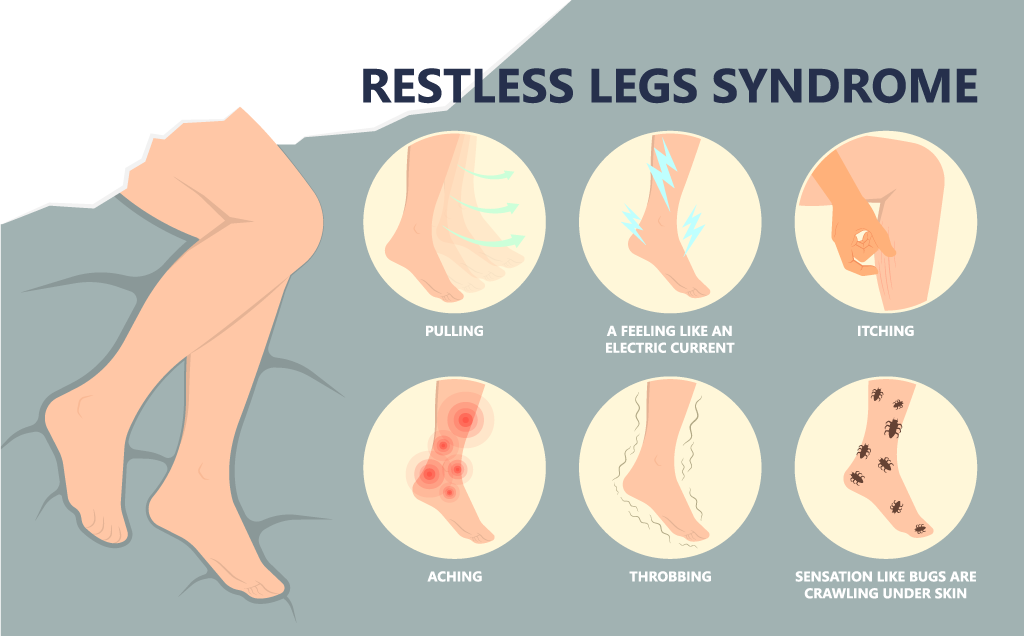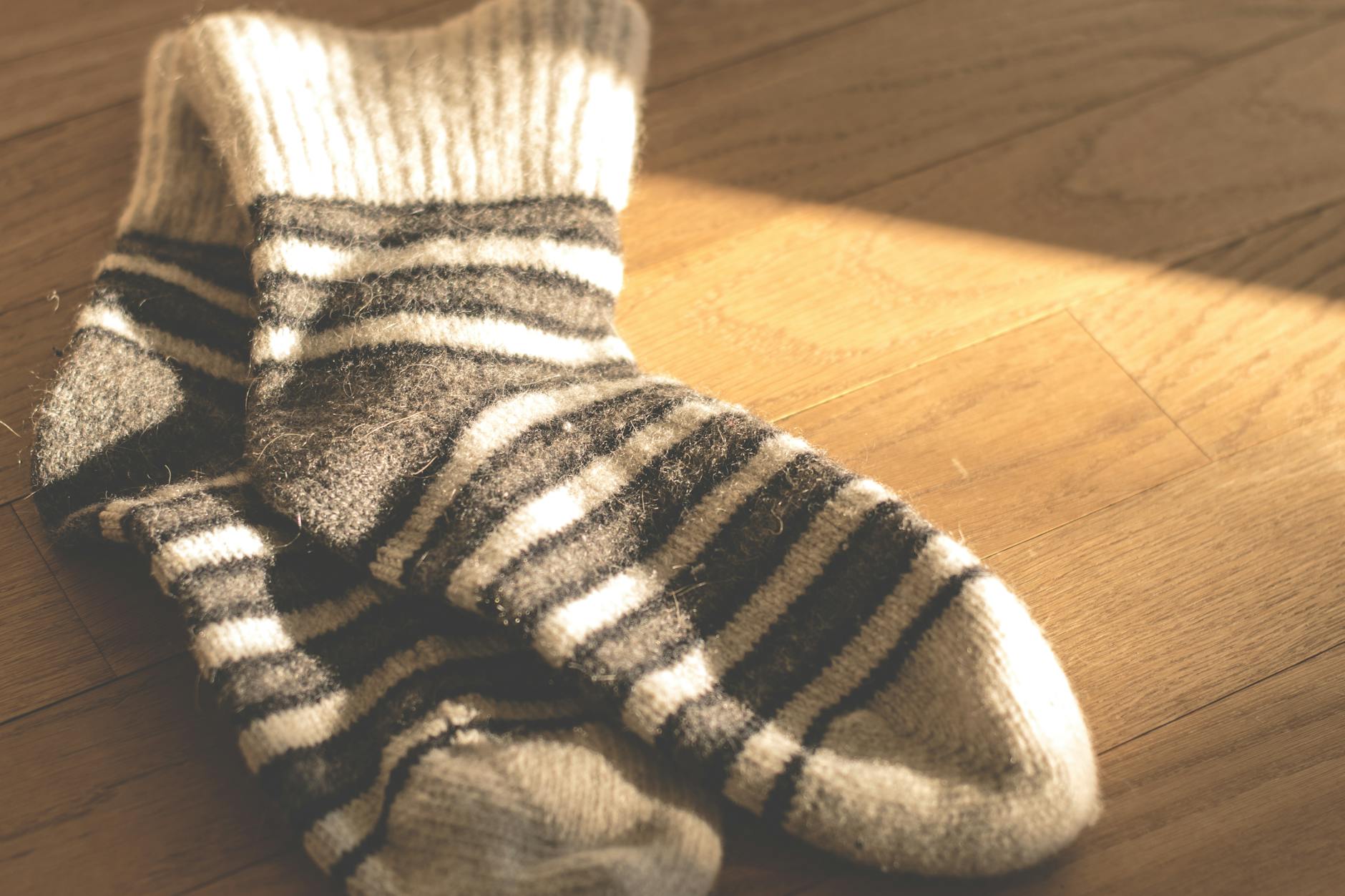Discover the secret to getting a good night’s sleep and finally beating RLS with these top tips and tricks!
Table of Contents
- Introduction to Restless Leg Syndrome (RLS)
- Understanding Sleep Apnea
- How Magnesium Can Help
- The Impact of Vitamin D on RLS
- Blood Pressure and RLS
- Mental Health Management for RLS Sufferers
- Daily Habits to Reduce RLS Symptoms
- When to Visit a Doctor
- Creative Ways to Talk About RLS with Friends
- Summary: Winning Against Restless Leg Syndrome
- FAQs About RLS
Introduction to Restless Leg Syndrome (RLS)
Restless Leg Syndrome, often referred to as RLS, is a condition that can make it hard for someone to stay still, especially when they are trying to relax or sleep. Imagine feeling like your legs just can’t settle down, making you want to move them constantly. This sensation isn’t just annoying; it can really disrupt a person’s day, especially when trying to get a good night’s rest.
What Is Restless Leg Syndrome?
Restless Leg Syndrome, or RLS, is when someone feels an irresistible urge to move their legs, often due to uncomfortable sensations like tingling, itching, or aching. It’s like having that feeling when you sit too long in one spot, but it doesn’t go away easily. People of all ages can experience RLS, but it’s more common in adults.
Common Symptoms of RLS
If you find yourself wanting to move your legs a lot, especially when you’re resting or trying to sleep, you might be experiencing RLS. Some signs to look out for include a sensation that’s difficult to describe and a strong urge to kick or move to relieve it. These feelings can be frustrating and prevent you from getting the rest you need.
Understanding Sleep Apnea
Sleep apnea is a common sleep disorder that can affect how well you rest at night. It is essential to understand what sleep apnea is and how it differs from other conditions like restless leg syndrome.
What Is Sleep Apnea?
Sleep apnea is when a person’s breathing is interrupted during sleep. This can happen multiple times throughout the night, leading to poor sleep quality and daytime fatigue. The most common type is called obstructive sleep apnea, where the airway becomes blocked, causing pauses in breathing.
How Sleep Apnea and RLS Can Be Confused
Both sleep apnea and restless leg syndrome can disrupt sleep patterns, leading to daytime drowsiness and other symptoms. However, they are distinct conditions with different underlying causes. It is crucial to recognize the symptoms of each to receive the appropriate treatment.
How Magnesium Can Help
Have you ever heard of magnesium? This mineral plays a vital role in our bodies and can actually help with something called restless leg syndrome (RLS). Let’s find out how!
Image courtesy of via Google Images
The Role of Magnesium
Magnesium is like a superhero mineral in our bodies. It helps keep our muscles moving smoothly, our heart beating steadily, and our bones nice and strong. Without enough magnesium, our bodies might not work as well as they should.
Magnesium and RLS
So, why is magnesium important for those with restless legs? Well, some studies suggest that not having enough magnesium in your body could make RLS symptoms worse. By making sure you have enough magnesium in your diet, you might help calm down those wiggly legs and get a better night’s sleep!
The Impact of Vitamin D on RLS
Vitamin D is a crucial nutrient that helps your body function properly. It plays a significant role in keeping your bones strong and supporting your immune system. Additionally, vitamin D helps your muscles and nerves work together smoothly.
Vitamin D Deficiency and RLS
When your body doesn’t get enough vitamin D, it can lead to various health issues, including restless leg syndrome. Research has shown that individuals with low levels of vitamin D are more likely to experience RLS symptoms.
A lack of vitamin D can affect the way your body absorbs and uses other essential nutrients, such as iron. Iron deficiency is another common factor linked to restless leg syndrome. Therefore, ensuring you have adequate levels of vitamin D is crucial for managing RLS.
Blood Pressure and RLS
Low blood pressure can have a significant impact on restless leg syndrome (RLS). So, let’s dive into how these two are connected and what it means for those dealing with this condition.

Image courtesy of via Google Images
Understanding Blood Pressure
Blood pressure is the force of blood pushing against the walls of your arteries as your heart pumps it around your body. It is essential for delivering oxygen and nutrients to your organs and tissues.
Low Blood Pressure and Its Symptoms
Low blood pressure, also known as hypotension, can lead to symptoms like dizziness, fainting, blurred vision, fatigue, and in some cases, restless leg syndrome.
Studies have shown that individuals with lower blood pressure may be more prone to developing RLS symptoms, possibly due to reduced blood flow to the legs and nerves.
Mental Health Management for RLS Sufferers
Living with Restless Leg Syndrome (RLS) can take a toll not only on your physical health but also on your mental well-being. It’s essential to address the mental aspects of RLS to improve your overall quality of life. Here are some tips for managing your mental health while dealing with RLS:
The Mental Toll of RLS
Dealing with chronic conditions like RLS can be mentally draining. The constant urge to move your legs, the discomfort while trying to rest, and the disruption to your sleep can all contribute to feelings of frustration, anxiety, and even depression. It’s crucial to recognize these emotions and address them proactively.
| Tips | Description |
|---|---|
| Avoid caffeine and alcohol | Both substances can worsen symptoms of Restless Leg Syndrome, so try to limit or eliminate them from your diet. |
| Exercise regularly | Regular physical activity can help reduce symptoms of RLS and improve overall sleep quality. |
| Practice relaxation techniques | Activities such as yoga, meditation, and deep breathing exercises can help reduce stress and improve sleep in RLS patients. |
| Establish a routine sleep schedule | Going to bed and waking up at the same time every day can help regulate your body’s internal clock and improve symptoms of RLS. |
| Consider medication options | If lifestyle changes aren’t enough, talk to your doctor about medications that can help alleviate symptoms of RLS. |
Mental Health Tips
1. Seek Support: Don’t hesitate to reach out to friends, family, or a mental health professional for support. Talking about your feelings and experiences can help alleviate some of the stress and anxiety associated with RLS.
2. Practice Relaxation Techniques: Incorporate relaxation techniques such as deep breathing, meditation, or yoga into your daily routine to help calm your mind and reduce stress levels.
3. Stay Positive: Focus on the things you can control rather than the ones you can’t. Engage in activities that bring you joy and try to maintain a positive outlook on life despite the challenges RLS may present.
4. Maintain a Routine: Establish a daily routine that includes regular sleep patterns, healthy meals, exercise, and relaxation. Having structure in your day can help reduce anxiety and improve your overall well-being.
By taking care of your mental health while managing RLS, you can enhance your ability to cope with the syndrome and improve your overall quality of life. Remember, it’s okay to seek help and prioritize your well-being.
Daily Habits to Reduce RLS Symptoms
Living with Restless Leg Syndrome (RLS) can be challenging, but implementing certain daily habits can help alleviate its symptoms. Here are some simple routines you can follow to lessen the effects of RLS:

Image courtesy of via Google Images
Diet & Nutrition
One important aspect of managing RLS is maintaining a balanced diet. Foods rich in iron, folate, and vitamin B12 can help improve RLS symptoms. Including green leafy vegetables, nuts, seeds, and lean meats in your meals can provide the essential nutrients needed to reduce leg discomfort.
Physical Activity
Regular physical activity can also play a significant role in managing RLS. Engaging in activities like walking, swimming, or yoga can help improve circulation and promote better sleep quality. Aim for at least 30 minutes of moderate exercise most days of the week to experience the benefits of reduced RLS symptoms.
When to Visit a Doctor
Recognizing when to seek medical help for Restless Leg Syndrome (RLS) is crucial in managing this condition effectively. While occasional discomfort may not require immediate attention, certain signs indicate the need to consult a healthcare provider.
Understanding RLS Severity
Severe and persistent symptoms of RLS can significantly impact your daily life, making normal activities challenging. If you experience frequent and intense sensations in your legs that disrupt your sleep or affect your quality of life, it may be time to seek medical advice. Persistent discomfort that lasts for an extended period without relief warrants a visit to a doctor to explore treatment options.
Preparing for a Doctor’s Visit
Before your appointment, it’s essential to gather relevant information to share with your doctor. Keep a diary documenting your symptoms, including when they occur, their duration, and any factors that seem to trigger or alleviate them. Be prepared to discuss your medical history, current medications, and any underlying conditions that may contribute to your RLS. Additionally, write down any questions or concerns you have about your symptoms or potential treatment options to ensure a productive discussion with your healthcare provider.
Creative Ways to Talk About RLS with Friends
If you ever need to explain your restless leg syndrome (RLS) to your friends, don’t worry! You can compare it to something they might understand. For example, you could say, “It feels like tiny ants crawling inside my legs, making me want to move them to feel better.” This can help your friends picture what you’re going through and show them that it’s a real thing that affects you.

Image courtesy of via Google Images
Handling Questions & Reactions
When you share about your RLS, your friends might have some questions or concerns. It’s important to stay calm and patient when answering them. If they ask why you can’t sit still, you can tell them that it’s because your legs feel uncomfortable and moving them helps relieve that feeling. Reassure your friends that you’re managing it with the help of a doctor and that their support means a lot to you.
Summary: Winning Against Restless Leg Syndrome
In understanding Restless Leg Syndrome (RLS), individuals need to recognize its impact on daily life, particularly sleep patterns. RLS can disrupt sleep and create discomfort in the legs, leading to restlessness and sleep disturbances.
Strategies for Battling RLS
One effective approach to combat RLS is by addressing underlying conditions like sleep apnea, which can exacerbate RLS symptoms. It is crucial to distinguish between sleep apnea and RLS to tailor proper treatment strategies.
Magnesium, an essential mineral, plays a vital role in the body’s functions and can aid in alleviating RLS symptoms. By incorporating magnesium-rich foods or supplements, individuals may experience relief from their restless leg sensations.
Additionally, vitamin D deficiency has been linked to RLS, underscoring the importance of maintaining adequate levels of this vitamin for overall health. Vitamin D supports bone health and muscle function, potentially easing RLS discomfort.
Low blood pressure can also contribute to RLS symptoms, emphasizing the need to monitor blood pressure levels and seek medical guidance when necessary. Understanding blood pressure and its implications can aid in managing RLS effectively.
Maintaining mental health is essential for individuals grappling with RLS, as the condition can take a toll on emotional well-being. Implementing mental health strategies, such as mindfulness and relaxation techniques, can help individuals cope with RLS-related stress.
Establishing healthy daily habits, including a balanced diet and regular physical activity, can significantly diminish RLS symptoms. By prioritizing nutritious eating and engaging in suitable exercises, individuals can enhance their overall well-being and combat RLS discomfort.
Know when to seek medical advice for RLS, particularly if symptoms persist or worsen over time. Consulting a healthcare provider can offer tailored treatment options and guidance for managing RLS effectively.
Employ creative communication strategies to discuss RLS with friends and peers, fostering understanding and support within social circles. By using relatable language and addressing common questions, individuals can raise awareness about RLS and garner support from loved ones.
In conclusion, by leveraging a combination of lifestyle modifications, treatment interventions, and effective communication, individuals can triumph over Restless Leg Syndrome, leading to improved sleep quality and enhanced overall well-being.
FAQs About RLS
What Does RLS Feel Like?
Restless Leg Syndrome feels like having an uncontrollable urge to move your legs, especially when you’re trying to relax or sleep. It can be like having little bugs crawling under your skin, making you want to squirm and move your legs constantly.
Can Kids Get RLS Too?
Yes, kids can also experience Restless Leg Syndrome. It’s not just something that affects grown-ups. Children can feel the discomfort and restlessness in their legs, just like adults do. So, if you think you might have RLS, don’t worry, you’re not alone!
What Helps to Stop the Leg Wiggles?
If you’re dealing with the annoying leg wiggles caused by RLS, there are a few things you can try to help reduce the symptoms. Firstly, making sure to move and stretch your legs regularly during the day can help. Paying attention to your sleep habits, like having a regular bedtime and creating a relaxing bedtime routine, can also make a difference. Some people find relief by using heating pads or taking warm baths before bedtime. If you’re having trouble managing your RLS symptoms, it’s essential to talk to your parents or a doctor for additional support and guidance.





